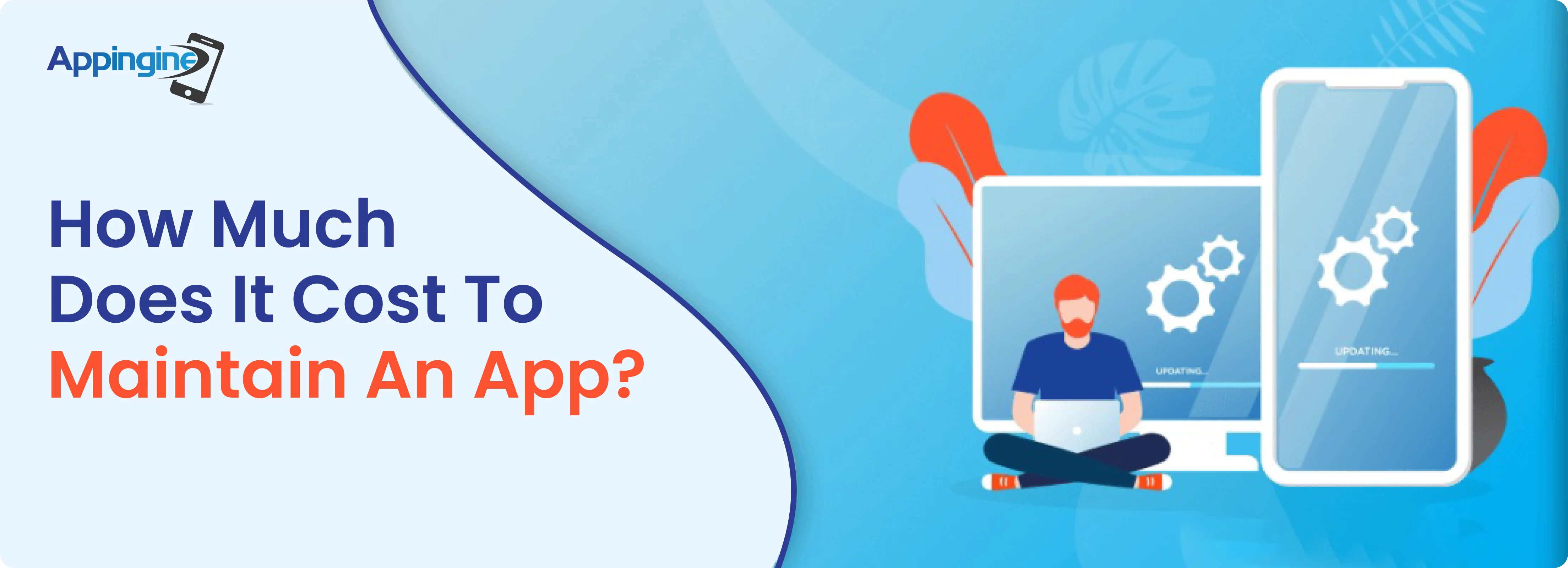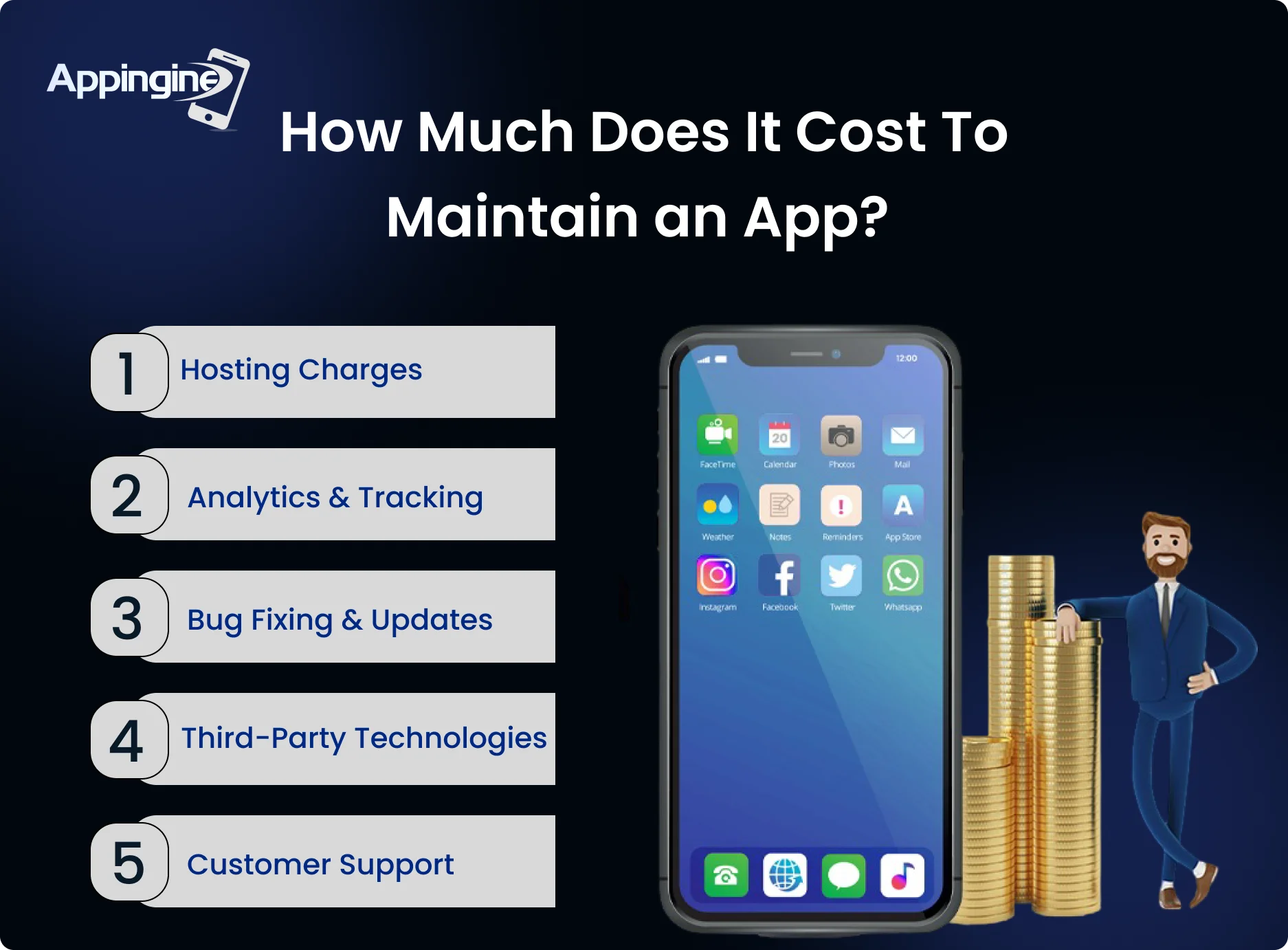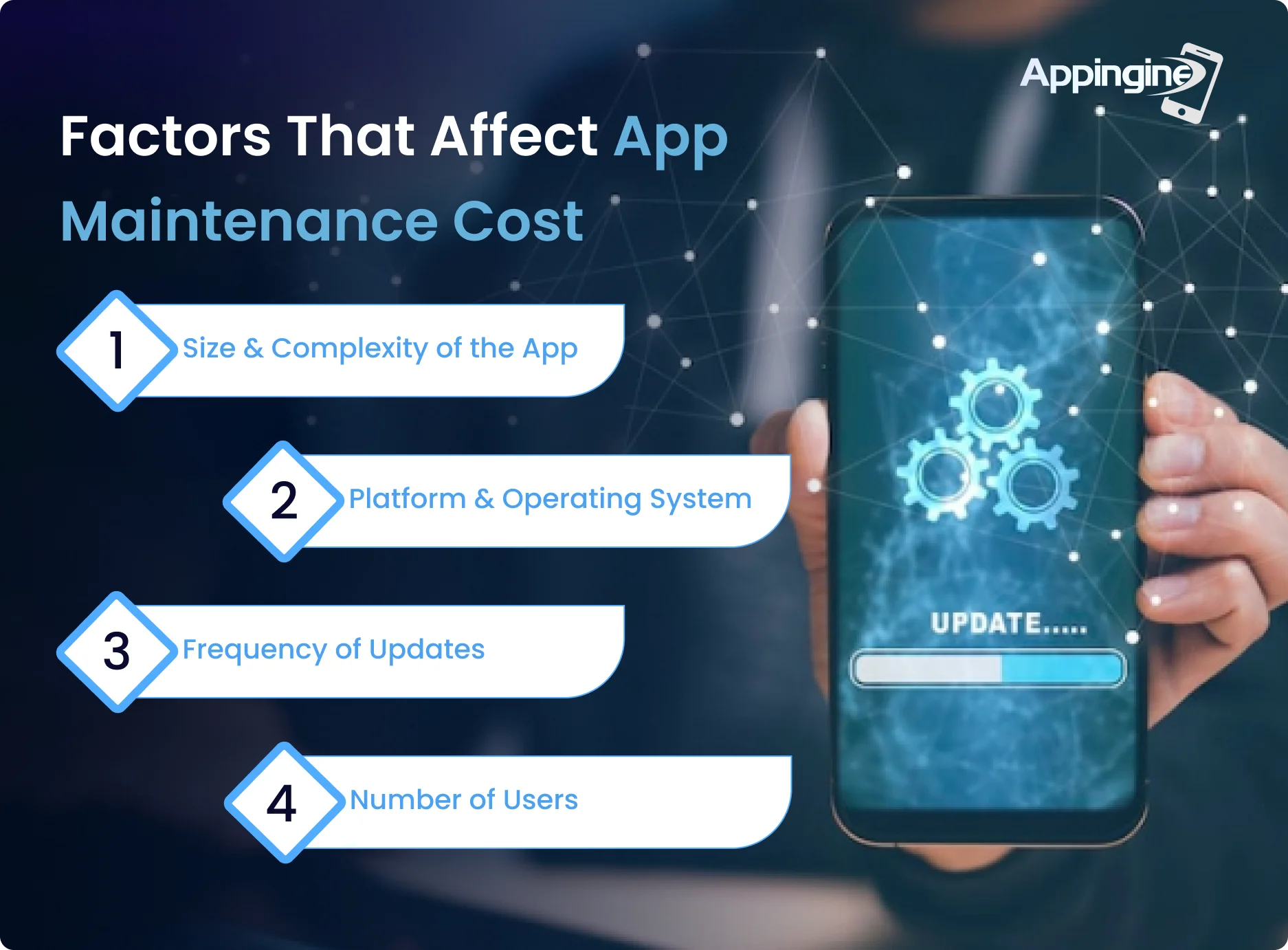Appingine
Let's Discuss Your Tech Solutions

For your app to succeed & achieve desired number of downloads, maintenance is key. The development of an app is important, but post-maintenance and support are the most important things that keep your app alive in the long run. However, the most important thing to highlight is the cost of maintaining the app to keep it ahead in the market.
Well, the development and maintenance cost of the app highly depends on factors, such as complexities, features, and functionalities that should be added in the app. Moreover, even the most well-developed app has a few bugs or errors that are highlighted in the maintenance phase and resolved by releasing a new version in the future. In case these issues are neglected and remain unresolved, they highly affect the user experience and are an open invitation to negative reviews and feedback.
To see why maintenance of the application after launching is necessary, read this comprehensive guide and uncover the importance, factors, and most importantly, the cost of app maintenance so your app can shine brighter in the competitive app market.
Head over to our app maintenance cost calculator and get an estimated quote.
Calculate Now!With the increase in demand for smartphones, the users are expected to reach 311 million by 2026. While coding is key, the success of the app also depends on publishing, marketing, & app maintenance & support after the app is launched.
An app needs regular updates to avoid crashes and user frustration. But neglecting this can lead to poor performance, invite bad reviews, and in most cases it leads to uninstallation of the apps. As more apps enter the market, maintaining quality is essential to avoid becoming obsolete and to stay in the market for a longer period.
Moreover, hiring a top app development company can resolve all the issues in your app, as each phase of the app development comes with its own concerns. But not to worry as in this blog we give you a full brief of the costs involved that also includes the factors. And keep in mind, the development of the app and maintenance fluctuates accordingly. So, stick with the blog so you can learn everything related to app maintenance cost.

In the app development lifecycle, maintenance begins after development and publication, often bringing additional costs that can reach up to 50% of the total development cost in the first year, then drop to around 15–25% in the following years. If your app runs on both platforms, such as Android and iOS, expect slightly higher maintenance expenses. On average, app owners should be prepared to have a maintenance budget of about $2,000 to $2,500 per month early on to keep things running smoothly. A good rule of thumb is to set aside 20% of your initial development cost for maintenance, so if your app costs $200,000 to build, plan on spending about $40,000 annually to maintain it.
If you are working with a top-notch development team, then their app estimation calculator, especially for the post-launch practices, will essentially help you to plan your budget accordingly. If you are one of those users that want to deeply learn about the app maintenance cost per year, then you should keep reading this blog.
Server and hosting costs are a major part of mobile app maintenance, and they fluctuate with the dependencies that are based on your app’s data and user load as well. The type of data any app can handle whether it’s mostly static content or heavy audio and video that helps in determining the server resources required such as CPU, memory and storage. Therefore, the estimated hosting prices can range from $70 to $320 per month which highly depends on the content size, active users and projected growth.
Maintaining a high-performing mobile app requires tracking and evaluating bugs, errors, complications, and other issues at an early time right after the deployment. Tools such as Google Analytics can provide insightful information that can help in making the right decision right on time. Not only that, but anyone can enhance user experience and react to problems more rapidly if they have a clear understanding of user needs and their behavior. Even if a lot of monitoring tools are free, more sophisticated models with more in-depth information could cost money. Furthermore, the process itself takes time, so it's critical to choose tools that complement your resource capacity and business objectives.
Frequent updates are essential for resolving bugs and improving the user experience. If the app is often reviewed, you will see that it is updated frequently to meet the needs of users and clients. Depending on how complicated the problem is, the cost of these upgrades might vary greatly. For example, repairing a basic bug or error may cost about $50, but changing a functional feature may take weeks and cost between $1,000 and $2,000. App owners must include continuing update and maintenance costs in their long-term plan because these costs are mostly determined by the size of the app and the type of modifications that are needed.
When creating the app, clients may decide to pay for the use of licensed technology. Therefore, there is a monthly fee for anything in your app that originates from someone else. You should think about figuring out these third-party expenses.
Any sudden disruption would make customers angry, and the same is true for mobile apps. If users suffer issues, having a reliable way to voice their concerns and receive helpful solutions could improve the bad experience. Moreover, spending money on customer service and constant support often leads to increased user satisfaction, despite the fact that it can exceed the estimated budget. Since the maintenance costs mainly depend upon the features and functionalities along with the complexities of the app, the more feature-rich the app is, the higher the maintenance costs may be. If you want your app to truly add value, it's best to plan for these expenses and follow industry best practices for sustained success.
There are several other services that are included while maintaining the post-launched app. You can have a deep analysis of the app maintenance services, which are mentioned in detail so you can have better knowledge about how these maintenance services are served according to the application.
Get your app maintained for flawless revenue generation by hiring our experts today!
Hire ExpertsA good rule of thumb in the app world is to budget about 50% of your original development cost for maintenance in the first year, then scale back to around 15–20% annually after that. But don’t treat that as a hard-and-fast rule because requirements and needs may differ with the passing time. Planning a major upgrade or adding new features? Then there should not be any hesitation to look at maintenance costs that climb back up to 50% of the original budget. The key is to stay flexible and prepared because keeping an app fresh, functional, and user-friendly is an investment that never really stops.
Application maintenance costs can swing widely based on how often you update your app, what tech stack is utilized behind it, how complex the app is, and the size of the development team as well. The more moving parts, the more it costs to keep everything running smoothly. Whether a regular update is pushed, latest technologies are used, or a large team is managed, all of it adds up to the cost of maintaining an app.
Let’s look at a comprehensive breakdown of maintaining an app:

There are multiple factors that highly affect the cost of app maintenance; a few of them are listed below with details for your ease.
This particularly depends on the app size. For example, if you are a developer building a small and cozy app like a small cabin, then it is easy for you to manage, but if you are developing a complex app, like a facial recognition app with a richness of features and functionalities as well as complex code, then you will need to have a look at the whole new level of upkeep. The bigger and more complex your app is, the more time, effort, and money it will need to maintain. Working with a professional app development company, such as Appingine, can help you maintain the functionality of your digital mansion by bringing in the necessary experience.
Building for iOS or Android isn’t just a choice—it’s a split path with different tools, rules, and requirements. These two platforms run on entirely different architectures, meaning what works for one won’t automatically work for the other. Maintaining an iOS app is a different game than keeping an Android app in shape, and each demands its own set of resources, updates, and expertise. If you're targeting both, be ready to double down on maintenance to keep your app running smoothly across the board.
Regular software upgrades maintain customer satisfaction and add new features, but they have a price. More testing, deployment effort, and opportunities for new bugs to infiltrate are all associated with each update. It's similar to tuning a high-performance vehicle in that it requires more care the more regularly you do it. Maintaining competitiveness requires frequent updates, but doing so requires time, money, and a keen eye for detail to prevent advances from becoming problems.
Your app will require more power behind the scenes as it gains popularity. More data to manage, more feedback to process, and more customer support tickets to resolve result from an expanding user base. Although having that issue is a good thing, it also means that maintenance requirements and expenses will increase. Size leads to success, and size entails responsibility, so be prepared to spend the money required to maintain your app's functionality as your user base expands.
Let’s dive deep into the price of maintaining a mobile app that is helpful for you to develop an app that comes along with the package of app maintenance.
Most apps make their money not from one big sale, but from lots of small purchases made over time, think in-app upgrades, subscriptions, or premium features. The key? Keeping users engaged for the long haul. The longer they stick around, the more revenue you generate. Sure, there’s an ongoing cost to maintain your app, but the payoff is worth it. Strong maintenance boosts user retention, improves ROI, and cuts down on the high cost of constantly finding new users. In short, a well-maintained app doesn’t just work better, it earns better.
Neglecting an app maintenance is not the right option, this will only invite disaster to your app, errors or glitches will continue to appear, the app's performance will fall behind and above all users will begin to uninstall it. Even worse, a growing number of negative reviews make it more difficult to draw in new consumers' attention. Maintaining your app's functionality, freshness and engagement is essential for survival in a world where user expectations are extremely high and competition never stops. Frequent updates and enhancements help you stay ahead of the competition and satisfy existing users.
Moreover, app maintenance reduces the risk of security breaches because the older your app is, it is more likely to be hacked and exploit bugs or security flaws if these aren’t constantly taken care of and being patched.
App development is merely the start of a much longer phase till the deployment; but it's just the beginning of the process. Today, maintaining your mobile app is crucial to ensure functionality, competitiveness and profitability. Maintenance affects every aspect of your app's functionality and user experience, from bug repairs and server expenses to customer service and regular upgrades. While depending on the complexity, features, platform and frequent updates, the price of maintaining a mobile app can vary from 15% to 50% of the initial budget for the app development; however, it is an essential investment for consistent success.
Wondering if the app is performing at its best, as it should be performing? Book a no-obligation consultation with our developers and identify areas for improvement.
Book A Free ConsultationA good rule of thumb is to allocate around 50% of your app’s initial development price of maintaining an app in the first year. This cost typically drops to 15–25% per year after that. So, if your app costs $200,000 to build, expect to spend $30,000–$50,000 annually on keeping it updated, secure and user-friendly.
Maintenance of the app ensures that it runs smoothly, stays compatible with ongoing trends, new devices and OS updates and continues meeting user expectations. It helps the developers help in preventing crashes, poor performance and security enhancements.
There is no doubt that a well-maintained software generates great ratings, encourages repeat in-app purchases or subscriptions and keeps users interested for longer. By extension of the app's lifecycle and raising user satisfaction, this lowers your user acquisition expenses and boosts ROI.
On average, developers spend $2,000 to $2,500 per month early on for proper app maintenance. App maintenance costs include hosting ($70–$320/month), bug fixes ($50–$2,000/fix), third-party fees (approx $9,000/year), IT support (approx $10,000/year) and payment gateway fees (~$150/month).
Several elements that influence the price of maintaining a mobile app include the app’s complexity, platform (iOS, Android, or both), frequency of updates, number of users and the third-party tools or integrations. More features and larger user bases typically require more resources which increases ongoing expenses.